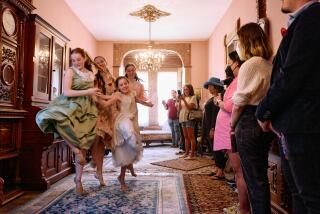DANCE REVIEW : Women in Jose Molina’s Troupe Excel
- Share via
If the Sunday afternoon performance of Jose Molina Bailes Espanoles had been a meal, you would have been surprised to find a choice of delectable entrees after such bland appetizers. But eventually the flamenco company’s three female dancers were released into savory gypsy-style solos after a very contained, decorous set of dances, done in various combinations with Molina.
In general, the first act choreography by Molina relied on subtle sways, careful step-tapping moves and the carving of space with delicately curved arms. It could be that the details could not be read on the spacious Ambassador Auditorium stage, bathed in a pinkish light that made it more bare. Or it could be that the dancers’ internal tensions were weakly organized, resulting in a few pretty pictures that matched the colorless orchestrations in selections of taped music.
But Act 2 left the merely pretty and the pale behind. A community of players and dancers populated the stage, including guitarists Carlos Rubio and Roberto Castellon and singer La Conja. From Nelida Tirado came exacting footwork at last. Against the black backdrop could be seen Juana Esposito’s wondrously expressive fingers on hands circling seductively, before her feet engaged in skipping zapateado . Aimee Murania was perhaps most commanding, with her strong spine supporting a beautifully open upper body.
Molina himself is strong on flourishes and poses, while in between, his impulses are more scattered than directed. But he has chosen his fellow dancers well.
More to Read
The biggest entertainment stories
Get our big stories about Hollywood, film, television, music, arts, culture and more right in your inbox as soon as they publish.
You may occasionally receive promotional content from the Los Angeles Times.










